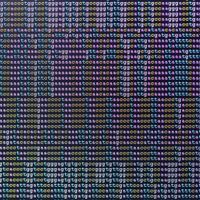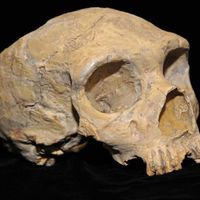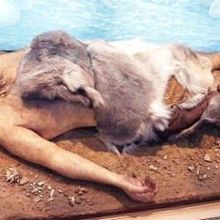Login
Subscribeneanderthal, genetics & genomics

“Dragon Man” May Replace Neanderthal as Our Closest Relative
Amanda Heidt | Jun 25, 2021 | 8 min read
A massive, well-preserved skull discovered in China in the 1930s belongs to a new species called Homo longi, researchers report, but experts remain skeptical about the evidence.

Gene-Edited Organoids Explore Neanderthal Brain Function
Jef Akst | Feb 12, 2021 | 3 min read
Using CRISPR to swap an archaic variant of the NOVA1 gene into human stem cells, researchers create organoids with neurodevelopmental differences from those carrying modern DNA.

The Biggest Science News of 2020
Kerry Grens | Dec 23, 2020 | 6 min read
Neanderthal DNA surprises in modern humans, the first blood test for Alzheimer’s, a discovery of new human salivary glands, and, oh yeah, a pandemic

Y Chromosome from Early Modern Humans Replaced Neanderthal Y
Jef Akst | Sep 24, 2020 | 5 min read
A selective advantage may have led the modern human Y chromosome to sweep through the Neanderthal population after it was introduced via interbreeding more than 100,000 years ago.

Genetics Steps In to Help Tell the Story of Human Origins
Katarina Zimmer | Sep 1, 2020 | 10+ min read
Africa’s sparse fossil record alone cannot reveal our species’ evolutionary history.

Remnants of Extinct Hominin Species Found in West African Genomes
Shawna Williams | Feb 13, 2020 | 2 min read
A study points to the existence of an ancient human relative that interbred with Homo sapiens.

Africans Have More Neanderthal DNA than Previously Thought
Jef Akst | Jan 30, 2020 | 4 min read
A new analysis of more than 2,500 human genomes indicates that modern Eurasians who acquired Neanderthal DNA during past interbreeding migrated back to Africa and spread those sequences.

Neanderthal Ancestry in Europeans Unchanged for Last 45,000 Years
Diana Kwon | Jan 23, 2019 | 4 min read
The findings of a new study contradict previous results from some of the same scientists that suggested Neanderthal DNA was gradually removed from modern human genomes.

Human-Specific Genes Implicated in Brain Size
Abby Olena, PhD | May 31, 2018 | 5 min read
Three members of a gene family called NOTCH2NL may have been involved in the evolution of humans’ big cortex.

“Minibrains” May Soon Include Neanderthal DNA
Ashley Yeager | May 14, 2018 | 1 min read
Brain organoids engineered to carry the genetic material could reveal how our brains are similar to and different from those of our closest relatives.

Effects of Neanderthal DNA on Modern Humans
Ruth Williams | Oct 5, 2017 | 3 min read
A new study reveals how Neanderthal DNA in the genomes of present-day British people influences their traits.

Common STD May Have Come from Neanderthals
Bob Grant | Oct 19, 2016 | 1 min read
Cross-species trysts likely spread human papillomavirus (HPV) to Homo sapiens, according to new research.

Contributors
The Scientist | Aug 1, 2016 | 3 min read
Meet some of the people featured in the August 2016 issue of The Scientist.

Clock Reset on Denisovan-Neanderthal Split
Kerry Grens | Mar 14, 2016 | 1 min read
Nuclear DNA from 430,000-year-old specimens indicates that Neanderthals had already diverged from their ancient-human predecessors.

Neanderthals’ Genetic Legacy
Ruth Williams | Feb 11, 2016 | 3 min read
Ancient DNA in the genomes of modern humans influences a range of physiological traits.

Denisovan DNA Reveals Human Roots
Bob Grant | Nov 19, 2015 | 2 min read
The ancient genomes of 50,000-year-old Denisovan teeth suggest the extinct species lived alongside Neanderthals and modern humans.

Neanderthal-Human Hybrid Unearthed
Bob Grant | Jun 22, 2015 | 3 min read
DNA from the 40,000-year-old bones of a modern human found in Europe contains Neanderthal genes.

45,000 Year-Old Bone Sequenced
Kerry Grens | Oct 24, 2014 | 2 min read
The oldest human genome to have been sequenced came from a leg bone preserved in Siberia.

Week in Review: June 16–20
Tracy Vence | Jun 20, 2014 | 2 min read
Early Neanderthal evolution; developing antivirals to combat polio; the mouth and skin microbiomes; insect-inspired, flight-stabilizing sensors
